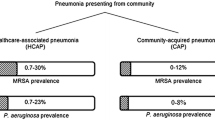Abstract
Despite medical breakthroughs, pneumonia continues to leave a large imprint on human health through its impact on mortality, healthcare costs, and antibacterial resistance. The care of patients with community-acquired and healthcare-associated pneumonia continues to evolve. Additionally, a number of regulatory bodies such as the Center for Medicare and Medicaid Services and the Joint Commission on Accreditation of Healthcare Organizations have chosen pneumonia as an indicator for quality care. This underscores the importance of understanding pneumonia not only for patient care but also for practice accreditation. This chapter reviews the diagnosis and management of these infections.
Access this chapter
Tax calculation will be finalised at checkout
Purchases are for personal use only
Similar content being viewed by others
References
Osler W (1901). The Principles and Practice of Medicine, 4th ed. New York: Appleton
Heron M (2007). Deaths: Leading Causes for 2004. Hyattsville, MD: National Center for Health Statistics
Halm EA, Teirstein AS (2002). Clinical practice. Management of community-acquired pneumonia. N Engl J Med 347:2039–2045
Jackson ML, Neuzil KM, Thompson WW et al. (2004). The burden of community-acquired pneumonia in seniors: Results of a population-based study. Clin Infect Dis 39:1642–1650
Feikin DR, Schuchat A, Kolczak M et al. (2000). Mortality from invasive pneumococcal pneumonia in the era of antibiotic resistance, 1995–1997. Am J Public Health 90:223–229
Lim WS, Macfarlane JT, Boswell TC et al. (2001). Study of community acquired pneumonia aetiology (SCAPA) in adults admitted to hospital: Implications for management guidelines. Thorax 56:296–301
Mandell LA, Wunderink RG, Anzueto A et al. (2007). Infectious Diseases Society of America/American Thoracic Society consensus guidelines on the management of community-acquired pneumonia in adults. Clin Infect Dis 44(Suppl 2):S27–S72
Hing E, Cherry DK, Woodwell DA (2006). National Ambulatory Medical Care Survey: 2004 summary. Adv Data (374):1–33
Wipf JE, Lipsky BA, Hirschmann JV et al. (1999). Diagnosing pneumonia by physical examination: Relevant or relic? Arch Intern Med 159:1082–1087
Fine MJ, Hough LJ, Medsger AR et al. (1997). The hospital admission decision for patients with community-acquired pneumonia. Results from the pneumonia Patient Outcomes Research Team cohort study. Arch Intern Med 157:36–44
Fine MJ, Auble TE, Yealy DM et al. (1997). A prediction rule to identify low-risk patients with community-acquired pneumonia. N Engl J Med 336:243–250
Lim WS, van der Eerden MM, Laing R et al. (2003). Defining community acquired pneumonia severity on presentation to hospital: An international derivation and validation study. Thorax 58:377–382
Capelastegui A, Espana PP, Quintana JM et al. (2006). Validation of a predictive rule for the management of community-acquired pneumonia. Eur Respir J 27:151–157
Meehan TP, Fine MJ, Krumholz HM et al. (1997). Quality of care, process, and outcomes in elderly patients with pneumonia. JAMA 278:2080–2084
Houck PM, Bratzler DW, Nsa W, Ma A, Bartlett JG (2004). Timing of antibiotic administration and outcomes for Medicare patients hospitalized with community-acquired pneumonia. Arch Intern Med 164:637–644
Metersky ML, Sweeney TA, Getzow MB et al. (2006). Antibiotic timing and diagnostic uncertainty in Medicare patients with pneumonia: Is it reasonable to expect all patients to receive antibiotics within 4 hours? Chest 130:16–21
MacDougall C, Powell JP, Johnson CK et al. (2005). Hospital and community fluoroquinolone use and resistance in Staphylococcus aureus and Escherichia coli in 17 US hospitals. Clin Infect Dis 41:435–440
American Thoracic Society; Infectious Diseases Society of America (2005). Guidelines for the management of adults with hospital-acquired, ventilator-associated, and healthcare-associated pneumonia. Am J Respir Crit Care Med 171:388–416
Babcock HM, Zack JE, Garrison T et al. (2004). An educational intervention to reduce ventilator-associated pneumonia in an integrated health system: A comparison of effects. Chest 125:2224–2231
Rello J, Gallego M, Mariscal D et al. (1997). The value of routine microbial investigation in ventilator-associated pneumonia. Am J Respir Crit Care Med 156:196–200
Yu VL, Singh N (2004). Excessive antimicrobial usage causes measurable harm to patients with suspected ventilator-associated pneumonia. Intensive Care Med 30:735–738
Beardsley JR, Williamson JC, Johnson JW et al. (2006). Using local microbiologic data to develop institution-specific guidelines for the treatment of hospital-acquired pneumonia. Chest 130:787–793
Singh N, Rogers P, Atwood CW et al. (2000). Short-course empiric antibiotic therapy for patients with pulmonary infiltrates in the intensive care unit. A proposed solution for indiscriminate antibiotic prescription. Am J Respir Crit Care Med 162:505–511
Chastre J, Wolff M, Fagon JY et al. (2003). Comparison of 8 vs 15 days of antibiotic therapy for ventilator-associated pneumonia in adults: A randomized trial. JAMA 290:2588–2598
Spellberg B, Powers JH, Brass EP et al. (2004). Trends in antimicrobial drug development: Implications for the future. Clin Infect Dis 38:1279–1286
Author information
Authors and Affiliations
Editor information
Editors and Affiliations
Rights and permissions
Copyright information
© 2010 Springer Science+Business Media, LLC
About this chapter
Cite this chapter
Nguyen, H.H. (2010). Pneumonia. In: Mainous III, A., Pomeroy, C. (eds) Management of Antimicrobials in Infectious Diseases. Infectious Disease. Humana Press. https://doi.org/10.1007/978-1-60327-239-1_9
Download citation
DOI: https://doi.org/10.1007/978-1-60327-239-1_9
Published:
Publisher Name: Humana Press
Print ISBN: 978-1-60327-238-4
Online ISBN: 978-1-60327-239-1
eBook Packages: MedicineMedicine (R0)




